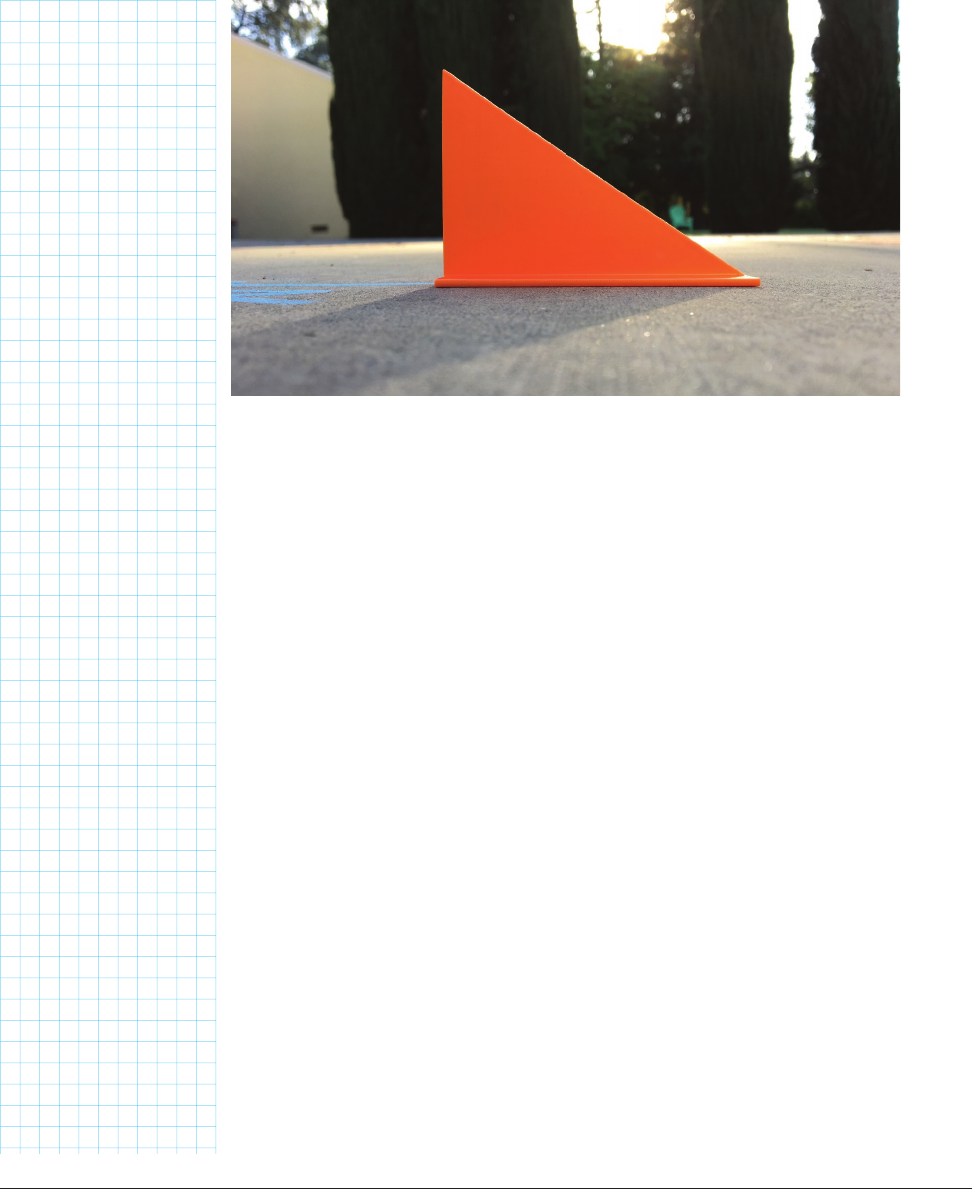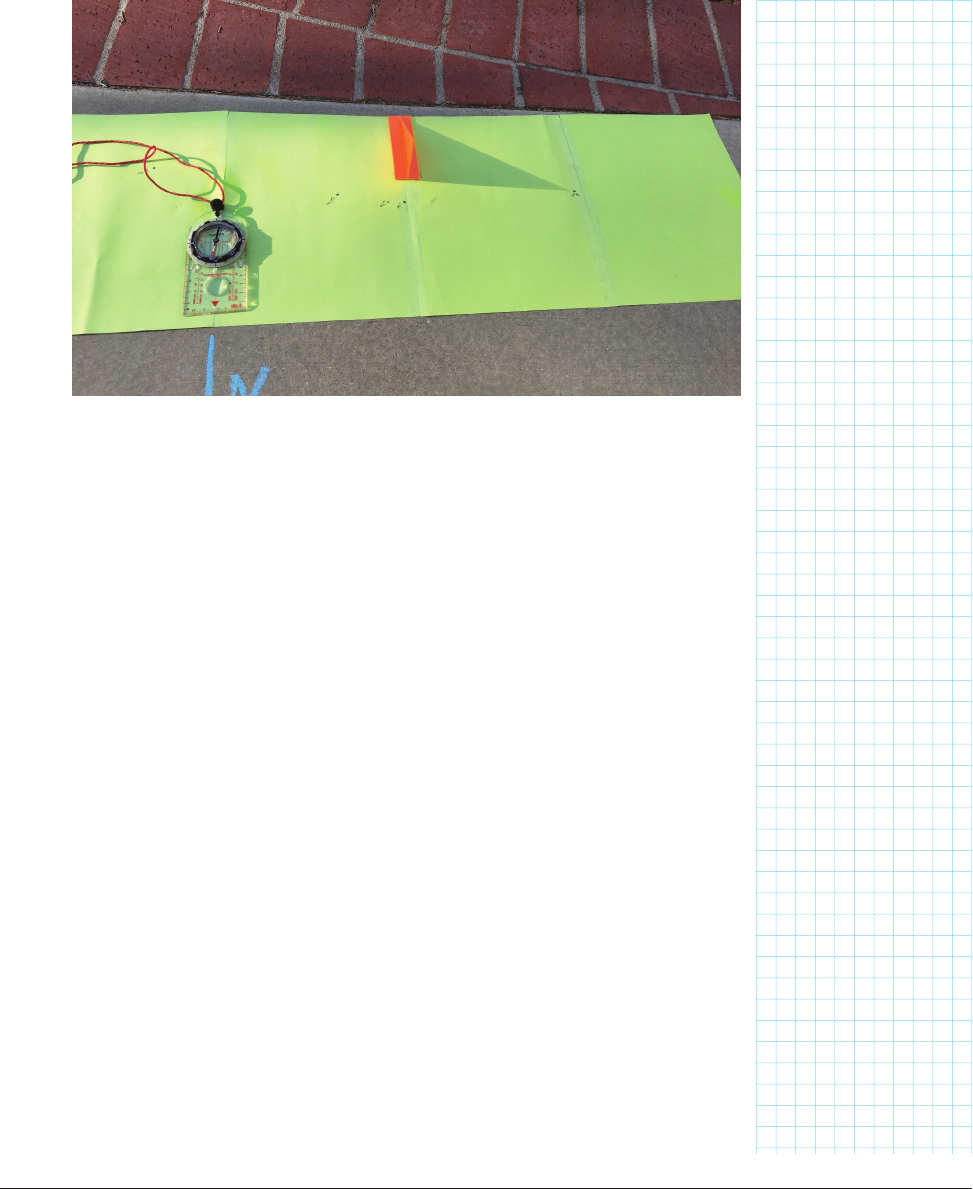
If you don’t have a 3D printer, create a right triangle from cardboard or foam
core with an angle at the base equal to your latitude, and create a base it can
stand on. In other words, make an equivalent in cardboard of the gnomon
created by sun_dial_gnomon.scad. Figure 12-5 shows the gnomon, created
for 34.1 degrees latitude.
We marked our example in early April, where the Equation of Time is about
-3 minutes. That means that the sun gets where it needs to go 3 minutes
late. So, to make up for that, we would observe 11 AM at 11:03, noon at 12:03
PM, and so on. If you did this in, say, mid-October when the Equation of Time
is about +12 minutes, you would make your observation 12 minutes before
the hour (11:48 AM for clock time of noon). We did this in Daylight Saving
Time, so the sun is near its maximum at about 1 PM. We are however at 118
degrees longitude, so (as discussed in Chapter 7) the solar time will be about
8 minutes earlier than the clock time hour. So we would expect our highest
sun at about 1:03 PM - 8 minutes, or 12:55 PM Pacific Daylight Time.
Once you have made your gnomon, take four pieces of 8.5x11 paper (or equiv-
alent) and tape them together down their long ends. Don’t overlap them. Lay
them side by side and then put down tape, so they don’t get crooked. (In other
words, end up with one 34x11 taped-together piece of paper.) There’s nothing
magic about the size. You just want something big enough that the longer
shadows will fit, which might be quite large in some latitudes. If it is exces-
sive, make the gnomon smaller (preserving the angles).
FIGURE 125: Gnomon (latitude angle, and due south, on the right)
Make: Geometry 249
248 Chapter 12: Geometry, Space and Time
Geometry_Chapter10_v15.indd 248Geometry_Chapter10_v15.indd 248 6/23/2021 9:11:23 AM6/23/2021 9:11:23 AM

Put your gnomon on the taped seam in the middle of the four pieces, and
mark where it is so you can replicate the setup easily. The gnomon’s angle
which is the same as your latitude should point at the sun (south). Use your
compass to line up the seam between sheets of paper, or at the edge, so that
it is aligned with a north-south line. (Figure 12-6).
Then, at your local clock time modified by the Equation of Time offset for the
day, make a mark of where the shadow is at 8 AM. We strongly suggest using
a pencil, not a pen, since you might discover something was a little off and
have to re-do some points.
There’s no need to adjust for where your longitude puts you in the time zone.
If you are going to read the time in the same place you are doing this mea-
surement, you are automatically calibrating it for your latitude and longitude.
(You can see why, in the era of sundials, every town had its own private time
zone.)
A day in May can be the same length as one in August, but sunrise and
sunset are earlier.
Repeat this process at least every two hours to make your marks (perhaps
with a few extra points near noon to get that area, where the lines are close
together, as accurate as possible). If there is no longer direct sun where
you started you can move the whole assembly, as long as you line it up with
FIGURE 126: Gnomon on paper, marking 8 AM. True north is marked with an arrow.
Make: Geometry 249
Geometry_Chapter10_v15.indd 249Geometry_Chapter10_v15.indd 249 6/23/2021 9:11:23 AM6/23/2021 9:11:23 AM

true north again and are sure the gnomon is in the same place on the paper
(Figure 12-7). Be sure that the ground is as flat and level as possible where
you do both observations. If you are going to make a sundial in something
more permanent than paper, you might want to make several observations at
each hour to be sure something wasn’t off.
Once you have taken your observations, mark where the point of the sundial
was (the point underneath where your latitude angle starts). Using a long
ruler, carefully draw a line from this point through each of the observed
points. Figure 12-8 shows one of these lines in red.
It might take you a few days to measure at enough times. Just be sure to
allow for the changing Equation of Time offset of when you take your mea-
surement. And don’t be afraid to erase a point or two if you discover you had
some stuff set up wrong, or if you did the Equation of Time backward. You’ll
see some erased points on our final graph if you look closely!
Once you’ve drawn your lines, you will have something that looks like Figure
12-9. (Draw up to and through your data point, to the edge of your paper.) You
can see that the sun was so bright that it faded the paper around the edges of
the gnomon after just a few days of standing outside in the California spring
sun. This makes it easy for us to see where the gnomon was, though.
After you do that for all the data points, you now have a minimalist sundial
(Figure 12-10). You could use this as a template to make something more
FIGURE 127: Marking time at Pacific Daylight Time 1:03 PM
Make: Geometry 251
250 Chapter 12: Geometry, Space and Time
Geometry_Chapter10_v15.indd 250Geometry_Chapter10_v15.indd 250 6/23/2021 9:11:24 AM6/23/2021 9:11:24 AM

permanent, perhaps by measuring the angles and re-drawing them on
something that will stand up to the elements better than a piece of paper.
USING YOUR SUNDIAL
To use your sundial, allow for the Equation of Time, and read the time based
on where the shadow has fallen. If the Equation of Time is negative, take your
reading the appropriate amount after the hour (e.g. 12:03 PM to look at the
noon marking if the Equation of Time is -3 minutes.)
FIGURE 128: A line running from the origin of the gnomon through the 6 PM marking.
FIGURE 129: Drawing the lines
Make: Geometry 251
Geometry_Chapter10_v15.indd 251Geometry_Chapter10_v15.indd 251 6/23/2021 9:11:25 AM6/23/2021 9:11:25 AM

In winter, the tips of the shadow will cluster farther out from the center point,
since the sun is lower and the shadows are therefore longer. In summer, they
will be closer in, but 3 PM should always fall pretty close to the 3 PM line
(allowing for Daylight Saving and the Equation of Time).
You can think of these radial lines in Figure 12-9 as the centerline of the ana-
lemma at that time of day at your longitude. The sun may be higher or lower
along that line at that time of day, but it will still be nearly on that line at all
times of the year. The angle of the gnomon lines up with the earth’s axis of
rotation, and the sun always moves across the sky at 15° per hour (360°/24
hours). That models the north/south part of the analemma simply for us.
There’s no simple way to model the east-west part of the analemma which
is, as we have mentioned, a combination of several factors, so you’re sort
of stuck with a correction for the Equation of Time. If you cruise the internet
looking at sundial designs you will come across a lot of elaborate attempts,
mostly with varying lines for different times of the year. As a side note, the
top of the shadow of the gnomon traces out a different hyperbola each day
(a straight line on the equinox). There’s a complicated construction for that
which would take a while to get into, but at bottom, there is a focus and circu-
lar directrix involved, after a lot of secondary construction to get to them.
FIGURE 1210: The finished sundial (shown without its gnomon).
Make: Geometry 253
252 Chapter 12: Geometry, Space and Time
Geometry_Chapter10_v15.indd 252Geometry_Chapter10_v15.indd 252 6/23/2021 9:11:25 AM6/23/2021 9:11:25 AM
..................Content has been hidden....................
You can't read the all page of ebook, please click here login for view all page.
